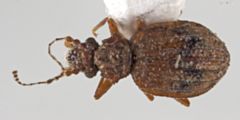Project 3982: Z. Yin, L. Lü, S. Yamamoto, M. K. Thayer, A. F. Newton, C. Cai. 2021. Dasycerine rove beetles: Cretaceous diversification, phylogeny and historical biogeography (Coleoptera: Staphylinidae: Dasycerinae). Cladistics. 37 (2):185-210.
Abstract
Within the hyperdiverse beetle family Staphylinidae, Dasycerinae is one of the smallest and most cryptic subfamilies, comprising a sole extant genus characterized by a latridiid beetle‐like body form. Little has been known about their early diversification, character evolution, phylogeny and historical biogeography because of limited fossil material and lack of a phylogeny integrating extant and extinct representatives. Here we report an unexpectedly diverse dasycerine fauna from the mid‐Cretaceous of northern Myanmar, including a new genus and four new species. To reconstruct the early evolutionary history of Dasycerinae, we present a phylogenetic framework of the subfamily based on a dataset integrating all extant and extinct taxa using parsimony, maximum‐likelihood and Bayesian methods. †Cedasyrus gen. n., characterized by distinct sexual dimorphism in antennal and elytral lengths, is recovered as the basal‐most lineage, sister to the remaining two extinct genera and all living Dasycerus species. †Vetudasycerus is recovered as sister to †Protodasycerus + Dasycerus. Among all extinct taxa, †Protodasycerus bears distinctly longer elytra, and appears to represent a transitional form from †Vetudasycerus to Dasycerus. Phylogenetic inferences and ancestral distribution reconstruction support an “Out‐of‐Orient” model for Dasycerinae. Either the Bering‐ or North Atlantic Land Bridge may have served as a passageway for dasycerine dispersal between Eurasian and North American continents. An elevation‐reconstruction analysis indicated that the ancestor of the extant Dasycerus probably lived at a high altitude and stayed at this elevation through the end of the Miocene. We propose that the extinction of dasycerine ancestors living on the Tethyan islands at low altitude was likely caused by sea‐level rise and climatic warming during the Late Cretaceous. The high‐altitude areas might have played the role of refugia that harboured subalpine derivatives which eventually gave rise to the extant Dasycerus.Read the article »
Article DOI: 10.1111/cla.12430
Project DOI: 10.7934/P3982, http://dx.doi.org/10.7934/P3982
| This project contains |
|---|
Download Project SDD File |
Currently Viewing:
MorphoBank Project 3982
MorphoBank Project 3982
- Creation Date:
08 April 2021 - Publication Date:
11 January 2022 - Project views: 4892

Authors' Institutions ![]()
- Hebei Normal University (Hebei Teachers University)
- Shanghai Normal University (Shanghai Teachers University)
- Nanjing Institute of Geology and Palaeontology, Chinese Academy of Sciences
- University of Bristol
- Field Museum of Natural History
Members
| member name | taxa |
specimens |
media |
| MorphoBank Curator Project Administrator | 2 | 1 | 1 |
Project has no matrices defined.
Project views 
| type | number of views | Individual items viewed (where applicable) |
| Total project views | 4892 | |
| Project overview | 565 | |
| Bibliography | 270 | |
| Media views | 1495 | Media search (1268 views); M835336 (227 views); |
| Views for media list | 424 | |
| Documents list | 366 | |
| Specimen list | 786 | |
| Taxon list | 986 |
Project downloads 
| type | number of downloads | Individual items downloaded (where applicable) |
| Total downloads from project | 33 | |
| Project downloads | 33 |

